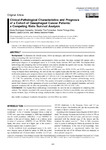Mostrar o rexistro simple do ítem
Clinical-pathological characteristics and prognosis of a cohort of oesophageal cancer patients: a competing risks survival analysis
| dc.contributor.author | Rodríguez-Camacho, Elena | |
| dc.contributor.author | Pita-Fernández, Salvador | |
| dc.contributor.author | López-Calviño, Beatriz | |
| dc.contributor.author | Pértega-Díaz, Sonia | |
| dc.contributor.author | Seoane-Pillado, Teresa | |
| dc.date.accessioned | 2022-06-15T10:06:15Z | |
| dc.date.available | 2022-06-15T10:06:15Z | |
| dc.date.issued | 2015-01-19 | |
| dc.identifier.citation | Rodríguez-Camacho E, Pita-Fernández S, Pértega-Díaz S, López-Calviño B, Seoane-Pillado T. Clinical-pathological characteristics and prognosis of a cohort of oesophageal cancer patients: a competing risks survival analysis. J Epidemiol. 2015;25(3):231-8. doi: 10.2188/jea.JE20140118. Epub 2015 Jan 19. PMID: 25716135; PMCID: PMC4341000. | es_ES |
| dc.identifier.issn | 0917-5040 | |
| dc.identifier.uri | http://hdl.handle.net/2183/30932 | |
| dc.description.abstract | [Abstract] Background: To determine the clinical course, follow-up strategies, and survival of oesophageal cancer patients using a competing risks survival analysis. Methods: We conducted a retrospective and prospective follow-up study. The study included 180 patients with a pathological diagnosis of oesophageal cancer in A Coruña, Spain, between 2003 and 2008. The Kaplan-Meier methodology and competing risks survival analysis were used to calculate the specific survival rate. The study was approved by the Ethics Review Board (code 2011/372, CEIC Galicia). Results: The specific survival rate at the first, third, and fifth years was 40.2%, 18.1%, and 12.4%, respectively. Using the Kaplan-Meier methodology, the survival rate was slightly higher after the third year of follow-up. In the multivariate analysis, poor prognosis factors were female sex (hazard ratio [HR] 1.94; 95% confidence interval [CI], 1.24-3.03), Charlson's comorbidity index (HR 1.17; 95% CI, 1.02-1.33), and stage IV tumours (HR 1.70; 95% CI, 1.11-2.59). The probability of dying decreased with surgical and oncological treatment (chemotherapy and/or radiotherapy) (HR 0.23; 95% CI, 0.12-0.45). The number of hospital consultations per year during the follow-up period, from diagnosis to the appearance of a new event (local recurrences, newly appeared metastasis, and newly appeared neoplasias) did not affect the probability of survival (HR 1.03; 95% CI, 0.92-1.15). Conclusions: The Kaplan-Meier methodology overestimates the survival rate in comparison to competing risks analysis. The variables associated with a poor prognosis are female sex, Charlson's comorbidity score and extensive tumour invasion. Type of follow-up strategy employed after diagnosis does not affect the prognosis of the disease. | es_ES |
| dc.language.iso | eng | es_ES |
| dc.publisher | Japan Epidemiological Association | es_ES |
| dc.relation.uri | https://doi.org/10.2188/jea.JE20140118 | es_ES |
| dc.rights | Atribución 3.0 España | es_ES |
| dc.rights.uri | http://creativecommons.org/licenses/by/3.0/es/ | * |
| dc.subject | Oesophageal neoplasms | es_ES |
| dc.subject | Therapeutics | es_ES |
| dc.subject | Survival | es_ES |
| dc.subject | Follow-up studies | es_ES |
| dc.title | Clinical-pathological characteristics and prognosis of a cohort of oesophageal cancer patients: a competing risks survival analysis | es_ES |
| dc.type | info:eu-repo/semantics/article | es_ES |
| dc.rights.access | info:eu-repo/semantics/openAccess | es_ES |
| UDC.journalTitle | Journal of Epidemiology | es_ES |
| UDC.volume | 25 | es_ES |
| UDC.issue | 3 | es_ES |
| UDC.startPage | 231 | es_ES |
| UDC.endPage | 238 | es_ES |
Ficheiros no ítem
Este ítem aparece na(s) seguinte(s) colección(s)
-
INIBIC-ECB - Artigos [50]






